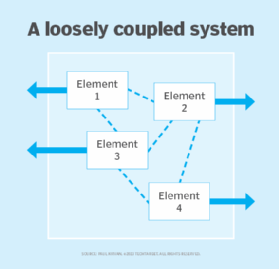Loosely Coupled Monolith
 Source:
Source: Our Comments
(2025-07-25T16:16.128Z)
Perplexity Query
(2025-07-25T16:16
.128Z)
Question:
Write a comprehensive one-page article about "Loosely Coupled Monolith".
Structure the article as follows:
- Introduction (2-3 sentences)
- Define the term and its significance
- Provide context for why it matters
- Main Content (3-4 paragraphs)
- Explain the concept in detail
- Include practical examples and use cases
- Discuss benefits and potential applications
- Address any challenges or considerations
- Current State and Trends (1-2 paragraphs)
- Discuss current adoption and market status
- Mention key players or technologies
- Highlight recent developments
- Future Outlook (1 paragraph)
- Predict future developments
- Discuss potential impact
- Conclusion (1-2 sentences)
- Summarize key points
- End with a forward-looking statement
Important Guidelines:
- Keep the total length to approximately one page (500-800 words)
- Use clear, accessible language
- Include specific examples and real-world applications
- Make it engaging and informative for a general audience
- Use markdown formatting for structure
Image References:
Include
A Loosely Coupled Monolith is a software architecture pattern where an application is organized as a single deployable unit (a monolith), yet its internal components are intentionally separated by clear boundaries and interact primarily through asynchronous messaging or well-defined contracts, rather than direct dependencies. This approach is significant because it provides many of the maintainability and scalability benefits of microservices while preserving the operational simplicity and performance of traditional monolithic deployments[2][3].
In modern software engineering, teams often face a dilemma: the rigidity and complexity of classic monolithic architectures versus the coordination overhead of distributed microservices[4]. A Loosely Coupled Monolith represents a balanced alternative, enabling large codebases to remain manageable, scalable, and adaptable as requirements evolve.
Understanding Loosely Coupled Monoliths
At its core, a Loosely Coupled Monolith enforces strict boundaries between different bounded contexts—distinct domains within the business model—inside a single codebase[2][3]. Each context is responsible for its own data and logic and communicates with others primarily through events or messages. For example, in an e-commerce application, the Order Management and Inventory modules would only share information via published events, not by reaching directly into each other's databases or internal states. This is typically achieved using in-process message brokers or event dispatchers, which decouple the timing and flow of information between components, ensuring asynchronous interaction[2][3].
Practical Example: Consider a payroll application with HR, Payroll Calculation, and Compliance modules. Rather than directly invoking each other's functions or sharing database tables, each module publishes domain events (such as "Employee Hired" or "Salary Updated"). Other modules subscribe to and react to these events via a message processor, updating their own state as needed without tight coupling to the internals of the sender[2].
Benefits:
- Maintainability: Since modules are isolated by boundaries and communicate through explicit contracts (events/messages), teams can modify one module with minimal risk of breaking others[2][3].
- Scalability: Modules can be internally optimized or even externally split into microservices in the future with less effort, as their contracts already support decoupled interaction[2].
- Productivity: Organizations can structure teams around bounded contexts, allowing focused work, independent development, and easier knowledge management[1][2].
- Reduced Operational Overhead: Unlike distributed microservices, a monolith avoids the complexity of deploying and monitoring multiple services.
Challenges:
- Strong discipline is required to enforce boundaries—unintentional direct calls or data sharing can reintroduce tight coupling[3].
- Asynchronous messaging inside a monolith may be harder to debug compared to traditional function calls.
- Not all development frameworks provide robust tooling for event-driven communication in monoliths, though this is improving.
Adoption and Industry Trends
Loosely Coupled Monoliths are increasingly recognized as a pragmatic step for organizations not ready to adopt a full microservices architecture[2][5]. Medium to large enterprises and cloud-native teams are leveraging this pattern, particularly when they want to avoid the operational challenges of distributed systems but still prepare for future modularization. Technologies such as .NET, Java Spring Boot, and Node.js commonly support event-driven patterns that facilitate loosely coupled designs within a monolith[2][3].
Key advocates include development leaders who have transitioned away from both classic monoliths (for their inflexibility) and pure microservices (for their complexity), recommending a loosely coupled approach as a middle ground[2][3]. Recently, major cloud vendors and open-source contributors have released libraries and frameworks that simplify event-driven messaging within monolithic codebases.
Adoption is growing, especially in regulated sectors (like finance and healthcare) where clear module boundaries also assist with compliance and auditability. Ongoing research and industry talks (as of 2025) focus on best practices for evolving a Loosely Coupled Monolith into microservices when scaling or business agility requirements demand it[3].
Future Outlook
As demands for agility, scalability, and robust software practices continue to rise, Loosely Coupled Monoliths are poised to become the default architectural style for many new enterprise applications. Future developments may include smarter in-process message brokers, better boundary enforcement tools, and seamless migration paths to microservices, amplifying both productivity and adaptability for software teams.
In summary, a Loosely Coupled Monolith offers the separation and scalability benefits of microservices within the simplicity of a single application, bridging the gap between outdated monoliths and complex service-oriented models. As software architecture evolves, expect loosely coupled patterns to influence both learning and practice in organizations seeking flexible yet manageable solutions.

